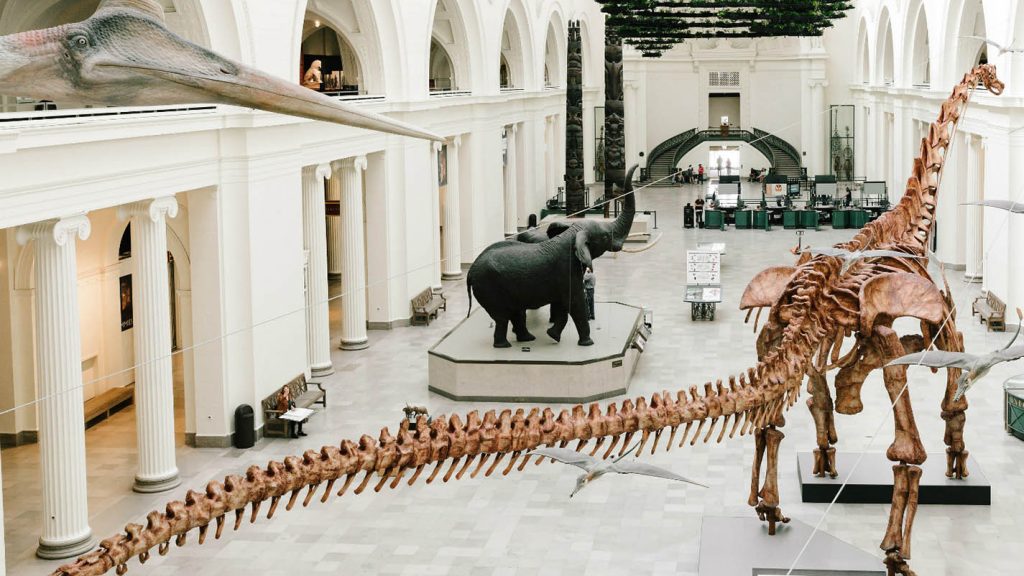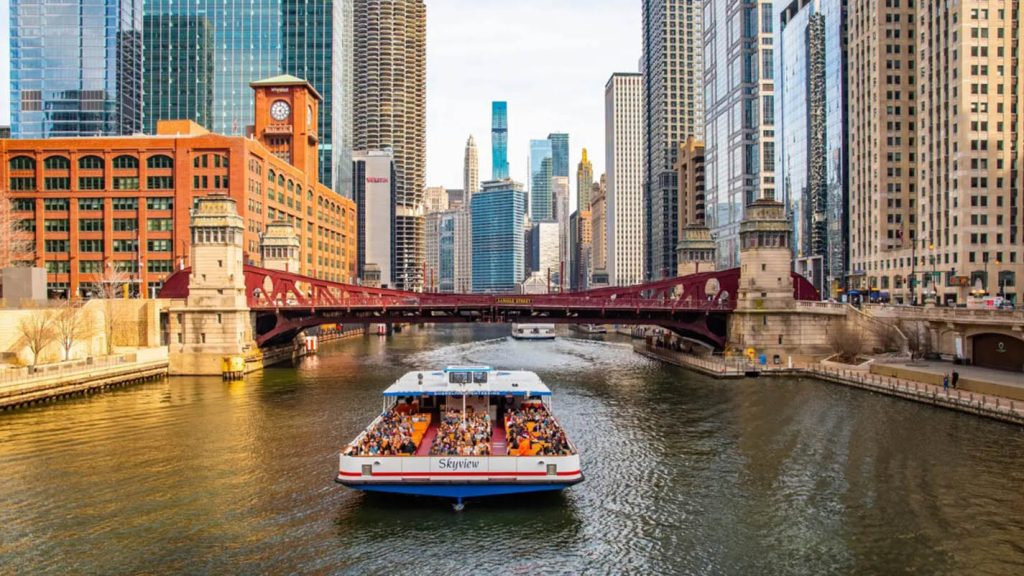Embarking on a journey through the captivating tapestry of Chicago’s history and architecture has been a profound exploration, unveiling layers of the city’s rich narrative. This narrative is an intricate dance between the contemporary skyline and echoes of the past, seamlessly blending into a vibrant urban symphony.
The Art Institute of Chicago: A Cultural Odyssey
Location: 111 S Michigan Ave, Chicago, IL 60603
Nestled in the heart of Chicago’s Grant Park, The Art Institute stands as a beacon of cultural richness. Its iconic lions guard the entrance, inviting visitors into a world where art transcends time.
Wandering through the expansive galleries of The Art Institute, the sensation was reminiscent of embarking on a transcendent odyssey through the corridors of history. The ambiance echoed with the resonance of centuries, enveloping me in an immersive experience that allowed a seamless traverse through the annals of human creativity. The curated collection, spanning from ancient artifacts to contemporary masterpieces, intricately stitched together a rich tapestry unraveling the evolution of artistic expression across time.
The exhibits within The Art Institute stood as a testament to meticulous curation, each showcase a carefully orchestrated tableau offering a nuanced comprehension of the trajectory of artistic evolution. Iconic works such as Grant Wood’s legendary “American Gothic” and Seurat’s captivating “A Sunday on La Grande Jatte” served as focal points within this vast expanse. Rather than being isolated entities, these renowned pieces became integral threads interwoven into the broader narrative of human creativity.
Grant Wood’s “American Gothic,” with its stoic portrayal of rural America, provided a glimpse into a particular epoch, encapsulating the essence of a bygone era. The sharp lines and somber expressions of the subjects resonated as a cultural commentary that surpassed its initial creation. Similarly, Seurat’s “A Sunday on La Grande Jatte” transported me to a different dimension with its pointillist technique, orchestrating an intricate dance of color and light that unfolded upon closer inspection.
The chronological arrangement of the exhibits facilitated a seamless progression through the annals of art history. Transitioning from ancient artifacts whispering tales of civilizations long past to vibrant canvases encapsulating the spirit of their respective epochs, the journey unfolded as a visual symphony. The carefully selected pieces not only showcased the technical prowess of the artists but also unraveled the socio-cultural contexts influencing their creations.
Within these hallowed halls, I uncovered the ability of art to transcend temporal boundaries, bridging the chasm between eras and beckoning me to appreciate the diverse facets of human creativity. The precision of curation at The Art Institute transformed the visit into more than a routine museum exploration; it metamorphosed into a pilgrimage through the corridors of time, where each brushstroke and sculpture whispered narratives of the human experience spanning across centuries.
The museum staff’s knowledge and passion for art enhance the visitor experience. Guided tours and informative panels enrich the understanding of each exhibit.
Pros:
Diverse Collection: Encompassing various art forms and eras.
Educational Value: Informative exhibits cater to both art enthusiasts and novices.
Central Location: Positioned within Grant Park, allowing easy access.
Cons:
Crowded Peak Hours: Weekends and holidays can lead to significant foot traffic.
Travel Route:
Accessible via public transport, with bus stops and train stations nearby. If driving, ample parking is available.
Discounts and Reservations:
Discounts often available for students and seniors. Advance tickets on the official website ensure a seamless entry process.
The Field Museum: Exploring Natural Wonders
Location: 1400 S Lake Shore Dr, Chicago, IL 60605

Situated on the shores of Lake Michigan, The Field Museum stands as a tribute to natural history, housing an extensive collection of specimens that weave together the Earth’s narrative.
Roaming through the towering exhibits of dinosaur skeletons, ancient artifacts, and interactive displays, I felt transported into the world’s epochs. “Sue,” the largest and most complete T. rex, is a mesmerizing centerpiece. The museum’s dedication to education is evident, making it an engaging experience for all ages.
The museum staff’s enthusiasm for science and history is contagious. Interactive elements and well-designed exhibits cater to a diverse audience.
Pros:
Diverse Exhibits: From ancient civilizations to biodiversity.
Educational Programs: Engaging workshops and presentations.
Lakefront Location: Stunning views of Lake Michigan.
Cons:
Large Size: Navigating the extensive museum may be challenging in a single visit.
Travel Route:
Accessible by public transport, including buses and the Metra Electric Line. Parking facilities available.
Discounts and Reservations:
Discounts for students and Chicago residents. Online reservations offer convenience, especially during peak times.
Millennium Park: An Urban Oasis
Location: 201 E Randolph St, Chicago, IL 60602
Nestled in the Loop, Millennium Park is a lush expanse of greenery amidst the city’s skyscrapers, offering a refreshing escape and hosting iconic sculptures and architecture.
Strolling through Millennium Park, I encountered the iconic Cloud Gate, affectionately known as “The Bean,” reflecting the city’s skyline in its polished surface. The Jay Pritzker Pavilion, an architectural marvel, hosts concerts and events. The park’s landscaping and public art, including the Crown Fountain, create a harmonious urban oasis.
The park is meticulously maintained, and the friendly park staff contributes to a welcoming atmosphere. The cleanliness and accessibility add to the overall positive experience.
Pros:
Iconic Art Installations: The Bean, Crown Fountain, and Pritzker Pavilion.
Green Spaces: A tranquil retreat within the bustling city.
Cultural Events: Regularly hosts concerts, festivals, and art exhibitions.
Cons:
Crowded Weekends: Popular among locals and tourists alike.
Travel Route:
Centrally located, accessible by public transport, and ample parking garages in the vicinity.
Discounts and Reservations:
Free entry to the park, but some events may require ticket purchases. No reservations needed for general park access.
Recommendations:
Chicago Architecture River Cruise: Navigating Skylines
Location: Departure points vary; popular ones include Michigan Avenue and Navy Pier.
A river cruise along the Chicago River provides a unique perspective on the city’s architectural marvels, showcasing iconic structures from a waterside vantage point.
Embarking on an architecture river cruise is akin to flipping through the pages of a living history book. The expert guides narrate the stories behind each building, from the historic Wrigley Building to the modern marvels of the Trump International Hotel and Tower. Witnessing the city’s skyline evolve with each turn of the river adds a dynamic dimension to the architectural exploration.

Tour operators offer knowledgeable guides, comfortable vessels, and often provide refreshments. The cruise’s pace allows for a comprehensive understanding of each structure.
Pros:
Architectural Insights: In-depth narration by knowledgeable guides.
Scenic Views: Unobstructed perspectives of iconic buildings.
Comfortable Cruise: Well-equipped vessels for a pleasant experience.
Cons:
Weather Dependency: Outdoor experience, subject to weather conditions.
Travel Route:
Multiple departure points along the Chicago River. Accessible by public transport or a short walk from downtown locations.
Discounts and Reservations:
Advance booking on reputable cruise websites often includes discounts. Group packages are available for those traveling with companions.
The Chicago Cultural Center: A Hidden Gem
Location: 78 E Washington St, Chicago, IL 60602
Nestled in the Loop, the Chicago Cultural Center is a historical landmark, housing a trove of cultural exhibits, performances, and art installations.
Often overlooked, the Chicago Cultural Center is a treasure trove of artistic expression. The building’s architecture, with its Tiffany dome, is an artwork in itself. The center hosts a diverse range of events, from live performances to rotating art exhibitions, making each visit a unique experience.
The staff’s passion for promoting culture is evident. The center’s commitment to accessibility and inclusivity adds to its charm.
Pros:
Architectural Splendor: Tiffany dome and intricate mosaics.
Cultural Diversity: Varied events representing different art forms.
Free Admission: Open to the public without an entry fee.
Cons:
Limited Space: Crowded during peak event times.
Travel Route:
Central location, easily accessible by public transport or a short walk from downtown.
Discounts and Reservations:
Free entry to the center, and reservations are generally not required for self-guided visits. Some special events may require booking in advance.
Garfield Park Conservatory: A Tropical Oasis in the City
Location: 300 N Central Park Ave, Chicago, IL 60624
Situated in the West Side, the Garfield Park Conservatory is an expansive botanical haven, housing a diverse collection of plants from around the world.
A visit to the Garfield Park Conservatory is a departure from the urban landscape into a lush oasis. The conservatory’s multiple rooms, including the Palm House and Fern Room, showcase the diversity of plant life. Walking through the greenery, I felt transported to different ecosystems, from tropical rainforests to arid deserts.
The conservatory staff’s dedication to maintaining a thriving ecosystem is evident. Informational panels and guided tours enhance the educational aspect of the visit.
Pros:
Botanical Diversity: A vast array of plant species under one roof.
Educational Value: Informative displays and guided tours.
Year-Round Attraction: A haven in all seasons.
Cons:
Crowded Weekends: Popular among families and nature enthusiasts.
Travel Route:
Accessible by public transport, with bus stops nearby. Limited parking available.
Discounts and Reservations:
Reasonably priced entry, with discounts for students and seniors. Reservations not typically required for general visits.
The Robie House: Frank Lloyd Wright’s Architectural Masterpiece
Location: 5757 S Woodlawn Ave, Chicago, IL 60637
Situated in the Hyde Park neighborhood, the Robie House is an iconic representation of Frank Lloyd Wright’s architectural brilliance.
Visiting the Robie House is akin to stepping into the mind of a visionary. Wright’s Prairie-style masterpiece showcases his innovative approach to design, emphasizing horizontal lines and blending with nature. The guided tours provide a comprehensive understanding of Wright’s philosophy and the historical context of the house.
The knowledgeable guides contribute significantly to the appreciation of the architectural nuances. Preservation efforts ensure the house’s authenticity is maintained.
Pros:
Architectural Significance: A key work in the Prairie School style.
Educational Tours: Guided tours enhance the visitor experience.
Historical Relevance: Immersion into the early 20th-century architectural ethos.
Cons:
Limited Accessibility: Some areas may be off-limits during tours.
Travel Route:
Accessible by public transport, with nearby bus stops. Limited street parking available.
Discounts and Reservations:
Discounts often available for students and seniors. Advance booking for guided tours recommended, especially during peak times.
Exploring the architectural marvels and historical landmarks of Chicago is a transformative journey that transcends time and space. From the cultural treasures housed in The Art Institute and the natural wonders within The Field Museum to the urban oasis of Millennium Park, each site unfolds a unique chapter in the city’s narrative. Additionally, the recommended sites—Chicago Architecture River Cruise, The Chicago Cultural Center, Garfield Park Conservatory, and The Robie House—offer diverse perspectives, ensuring a comprehensive exploration of Chicago’s vibrant heritage. Navigating these sites, I discovered not only the physical beauty of the city but also the soulful stories etched into its architecture and history.